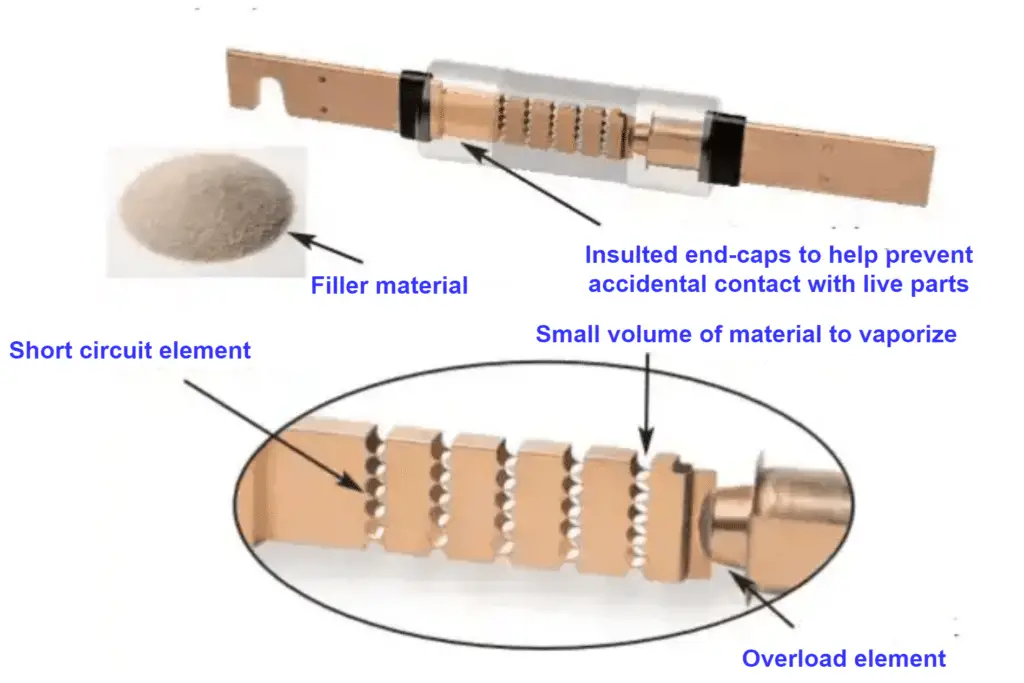Time delay fuses do not blow out on momentarily current spikes and provide protection against overload and short circuit. They are used for those applications where momentarily spikes of current occurs during the starting of the electrical equipment.
The transformer and induction motor draws a large current at the start, therefore, for these applications, the time delay switch is used for protection of motors and transformers. If we compare the normal fuse and a time delay fuse, a 5 amperes rating normal fuse blows out when current in the circuit exceeds above 5 amperes, on the other hand, time delay fuse does not blow out immediately and takes some time.
Therefore, the time delay fuses are also known as slow blow fuses and dual element time delay fuses. The sizing of these fuses are almost equal to the normal running load of the equipment because of time delay characteristics of the slow blown fuses.
The dual elements fuses are capable of overriding the full load current of the equipment and reduce the unnecessary fuse elements opening. They can be used for inductive loads, capacitive loads and resistive loads.
The time delay switch is used for induction motor as a backup protection with motor protection relay. The motor draws a high current in the case of single phasing, and the overload relay protects the motor in this case. However, if thermal overload relay does not trip on overloading condition, then the slow blow fuse gets open and protects the motor.
Construction of dual Element Time Delay Fuses
Dual element fuses, as its name suggest, has two separate element- one for short circuit and another for overload protection. The overload element has a soldered joint with a spring connection arrangement. The short circuit protection element has a copper conductor with a portion that provides restricted current flow.

These elements are in-house in a tube that has arc quenching filler material. The tube protects the accidental touching contact with live part.
Working of dual Element Time Delay Fuses
The working of time delay fuse is the same as of fast acting fuse. The dual element fuses or time delay fuses also have a heating element like fast acting fuses, but the heating rate of the element is slower than the fast acting fuses.
The dual element fuses have a fuse element made of a heat-sensitive material, typically a metal alloy. The heating element heats up when the current flow through it due to electrical resistance of the heating element. the standard fast-acting fuse has a lower element resistance than the time delay fuse and the heating happens quickly and interrupt the circuit instantaneously.
Time delay fuse has a higher melting point and a thicker cross-section in comparison to a fast-acting fuse. The fuse element heats up slowly under overload condition and cause delay in melting process of fuse element. The delay in melting of fuse element allow the fuse to tolerate short-duration current surges.
The restricted portion of the time delay fuse greatly reduce the short circuit let-through current through the fuse. The fuse allow 100 to 200 % momentary overloads of the fuse rating and the circuit remains close-circuited. However, if the overload persist, then the solder joint melts and the spring pulls back the contact holder, causing opening of the circuit.
The small volume of the metal in the restricted portion evaporates during short circuit, and cause arc formation. The filler material surrounding the fuse element absorbs the heat produced by arc and it creates a insulation barrier. Thus, arc is extinguished by the filler material.
Advantages of slow-blown fuses
- When used for motor protection, dual element fuses can be sized close to the motor full load current, thereby reducing the cost.
- Provide improved overload protection.
- They have the capability to override normal current surges and avoid nuisance operations. Thus, minimizing downtime and maintaining the continuous operation of critical systems.
- Provides reliable short circuit protection in circuits with frequent current surges and overloads occur.
- They provide backup protection with other protective devices. Example- The dual element fuse with thermal overload relay in motor.
- Induction motor takes high current under single phasing condition. The Dual element fuses blow out in single phasing and protect the motor.
- The cost of the time delay fuses is less than the overload relay. Thus, slow blow fuses are cost effective solution.
- Time delay fuses can be used in coordination with other protective devices.
Application of time-delay fuses
- Motor Protection: Motors draws high inrush currents at start. The time delay fuse does not blow during inrush current period and blow out if the overcurrent persist for a longer period of a time. Thus, the fuses prevents unnecessary tripping.
- Lighting Systems: Fluorescent lights, high-intensity discharge (HID) lamps, and all types of gas discharge lamps draw momentary inrush currents when switched on. Time delay fuses do not interrupt the lighting circuit for these temporary current spikes.
- Power Supplies: The electronics circuit and capacitors demands higher current on switching the power supplies. The dual element fuses sustain the momentarily current surges and protect the power supply circuit.
- HVAC Systems: Heating, ventilation, and air conditioning (HVAC) systems have compressors and fans that draw inrush currents during startup. dual element fuses avoid tripping of the electrical circuit during startup.
- Transformers: Transformers draw high inrush currents during startup. Dual element fuses protect the primary and secondary windings of transformers from excessive currents during this startup period.